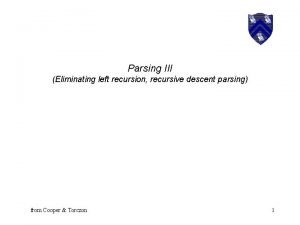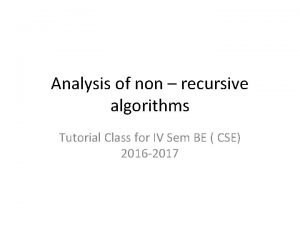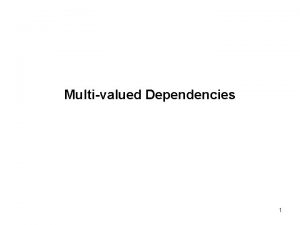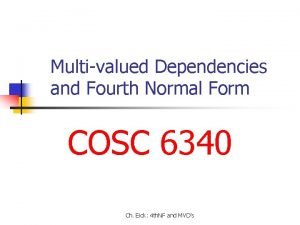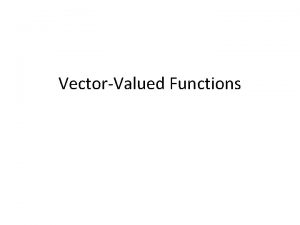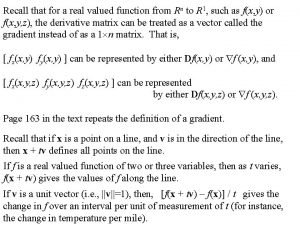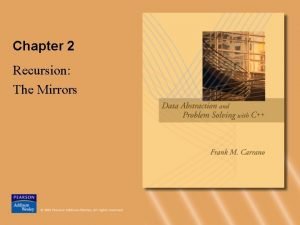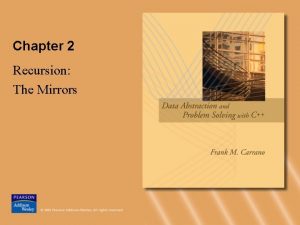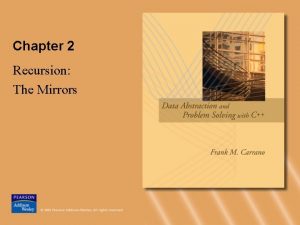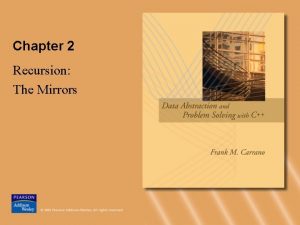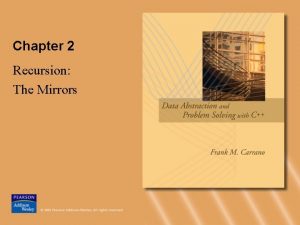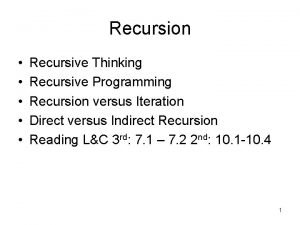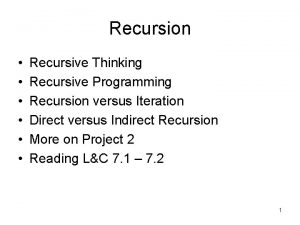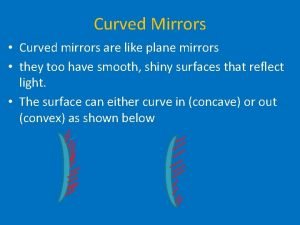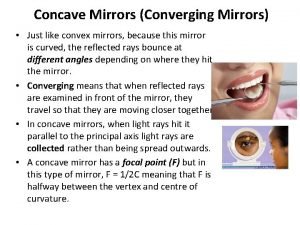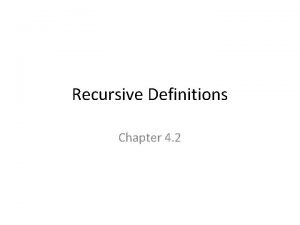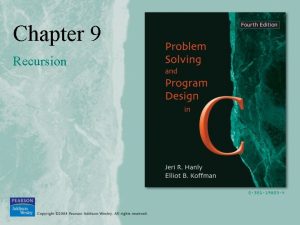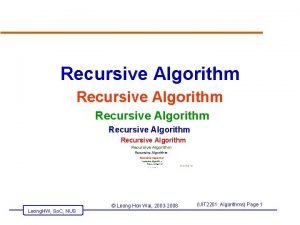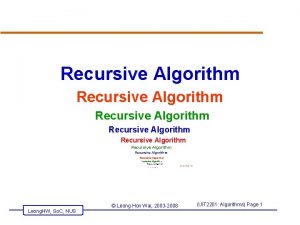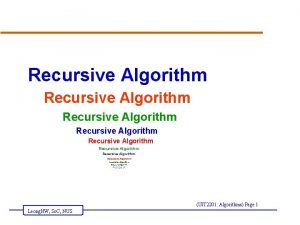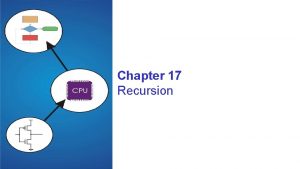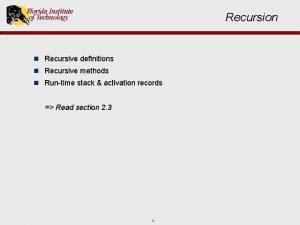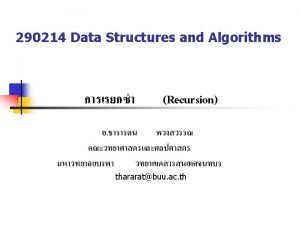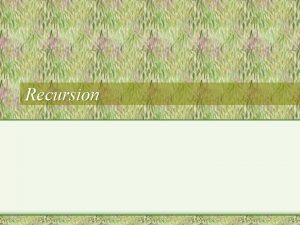Chapter 2 Recursion The Mirrors A Recursive Valued










































- Slides: 42

Chapter 2 Recursion: The Mirrors






A Recursive Valued Method: n ! (n 階乘) • Problem – 計算出 n! (以函式 factorial(n) 表示) • factorial(n) 的列舉式定義(可用迴圈完成, 請自己寫寫看) factorial(n) = n * (n-1) * (n-2) * … * 1 for any integer n > 0 factorial(0) = 1 © 2005 Pearson Addison-Wesley. All rights reserved 7

A Recursive Valued Method: The Factorial of n • factorial(n) 的遞迴定義 factorial(n) = 1 if n = 0 = n * factorial(n-1) if n > 0 © 2005 Pearson Addison-Wesley. All rights reserved 8

A Recursive Valued Method: The Factorial of n • 遞迴關係 – 一個新項目的值是利用之前項目的值來產生 的數學公式 – Example factorial(n) = n * [(n-1) * (n-2) * … * 1] = n * factorial(n-1) © 2005 Pearson Addison-Wesley. All rights reserved 9


範例 © 2005 Pearson Addison-Wesley. All rights reserved 11

A Recursive Valued Method: The Factorial of n Figure 2. 3 A box © 2005 Pearson Addison-Wesley. All rights reserved 12

A Recursive Valued Method: The Factorial of n © 2005 Pearson Addison-Wesley. All rights reserved 13

A Recursive Valued Method: The Factorial of n © 2005 Pearson Addison-Wesley. All rights reserved 14

A Recursive Valued Method: The Factorial of n © 2005 Pearson Addison-Wesley. All rights reserved 15

A Recursive Valued Method: The Factorial of n © 2005 Pearson Addison-Wesley. All rights reserved 16



Multiplying Rabbits (The Fibonacci Sequence) • Problem – 在第 n 個月共有幾對兔子? • 遞迴關係 rabbit(n) = rabbit(n-1) + rabbit(n-2) © 2005 Pearson Addison-Wesley. All rights reserved 19

Multiplying Rabbits (The Fibonacci Sequence) Figure 2. 10 Recursive solution to the rabbit problem © 2005 Pearson Addison-Wesley. All rights reserved 20

Multiplying Rabbits (The Fibonacci Sequence) © 2005 Pearson Addison-Wesley. All rights reserved 21

Multiplying Rabbits (The Fibonacci Sequence) • 基本狀況 – rabbit(2), rabbit(1) • 遞迴定義 rabbit(n) = 1 if n is 1 or 2 = rabbit(n-1) + rabbit(n-2) if n > 2 • 費氏序列 – 以 rabbit(1), rabbit(2), rabbit(3), … 這些值形 成的序列 © 2005 Pearson Addison-Wesley. All rights reserved 22




Mr. Spock’s Dilemma • 基本狀況 (Choosing k out of n Things) – 自 k 個物件取出 k 個只有一種取法 c(k, k) = 1 – 什麼都不取的取法也只有一種 c(n, 0) = 1 – 無法取出比 n 更多個物件 c(n, k) = 0 if k > n © 2005 Pearson Addison-Wesley. All rights reserved 26

Mr. Spock’s Dilemma (Choosing k out of n Things) • 遞迴定義 c(n, k) = 1 1 0 c(n-1, k-1) + c(n-1, k) © 2005 Pearson Addison-Wesley. All rights reserved if k = 0 if k = n if k > n if 0 < k < n 27

Mr. Spock’s Dilemma (Choosing k out of n Things) Figure 2. 12 The recursive calls that c(4, 2) generates © 2005 Pearson Addison-Wesley. All rights reserved 28

Searching an Array: 找到陣列最大值 • 遞迴解法 if (an. Array 只有一個項目) { max. Array(an. Array) 就是該項目 } else if (an. Array 有不只一個項目) { max. Array(an. Array) 是以下兩數之最大值: max. Array( an. Array 的前面一半陣列) 及 max. Array( an. Array 的後面一半陣列) } // end if © 2005 Pearson Addison-Wesley. All rights reserved 29

Searching an Array: Finding the Largest Item in an Array Figure 2. 13 Recursive solution to the largest-item problem © 2005 Pearson Addison-Wesley. All rights reserved 30


Finding the kth Smallest Item in an Array Figure 2. 18 A partition about a pivot © 2005 Pearson Addison-Wesley. All rights reserved 32

Finding the kth Smallest Item in an Array • Let: k. Small(k, an. Array, first, last) = an. Array[first. . last] 中第 k 個最 小項目 © 2005 Pearson Addison-Wesley. All rights reserved 33

Finding the kth Smallest Item in an Array • 解答(假設陣列已排序): k. Small(k, an. Array, first, last) = k. Small(k, an. Array, first, pivot. Index-1) if k < pivot. Index – first + 1 = p if k = pivot. Index – first + 1 = k. Small(k-(pivot. Index-first+1), an. Array, pivot. Index+1, last) if k > pivot. Index – first + 1 © 2005 Pearson Addison-Wesley. All rights reserved 34

Organizing Data: The Towers of Hanoi (河內塔) Figure 2. 19 a and b a) The initial state; b) move n - 1 disks from A to C © 2005 Pearson Addison-Wesley. All rights reserved 35

The Towers of Hanoi Figure 2. 19 c and d c) move one disk from A to B; d) move n - 1 disks from C to B © 2005 Pearson Addison-Wesley. All rights reserved 36

The Towers of Hanoi • 擬程式碼 solve. Towers(count, source, destination, spare) if (count is 1) { 直接將盤子由 source 移至 destination } else { solve. Towers(count-1, source, spare, destination) solve. Towers(1, source, destination, spare) solve. Towers(count-1, spare, destination, source) } //end if © 2005 Pearson Addison-Wesley. All rights reserved 37



Summary • Recursion solves a problem by solving a smaller problem of the same type • Four questions: – How can you define the problem in terms of a smaller problem of the same type? – How does each recursive call diminish the size of the problem? – What instance of the problem can serve as the base case? – As the problem size diminishes, will you reach this base case? © 2005 Pearson Addison-Wesley. All rights reserved 40

Summary • A recursive call’s postcondition can be assumed to be true if its precondition is true • The box trace can be used to trace the actions of a recursive method • Recursion can be used to solve problems whose iterative solutions are difficult to conceptualize © 2005 Pearson Addison-Wesley. All rights reserved 41

Summary • Some recursive solutions are much less efficient than a corresponding iterative solution due to their inherently inefficient algorithms and the overhead of method calls • If you can easily, clearly, and efficiently solve a problem by using iteration, you should do so © 2005 Pearson Addison-Wesley. All rights reserved 42
 Single valued and multi valued attributes
Single valued and multi valued attributes To understand recursion you must understand recursion
To understand recursion you must understand recursion Left factoring algorithm
Left factoring algorithm Non recursive algorithm
Non recursive algorithm Socially valued resources
Socially valued resources Multi valued dependencies
Multi valued dependencies Multi valued dependency
Multi valued dependency Communication and employability skills for it
Communication and employability skills for it Chapter 8 thinking language and intelligence
Chapter 8 thinking language and intelligence Which of these are valued as a special zero-growth case
Which of these are valued as a special zero-growth case Find the domain of the vector valued function
Find the domain of the vector valued function Real valued function
Real valued function Chapter 17 reflection and mirrors
Chapter 17 reflection and mirrors Hình ảnh bộ gõ cơ thể búng tay
Hình ảnh bộ gõ cơ thể búng tay Slidetodoc
Slidetodoc Bổ thể
Bổ thể Tỉ lệ cơ thể trẻ em
Tỉ lệ cơ thể trẻ em Voi kéo gỗ như thế nào
Voi kéo gỗ như thế nào Tư thế worm breton là gì
Tư thế worm breton là gì Hát lên người ơi
Hát lên người ơi Kể tên các môn thể thao
Kể tên các môn thể thao Thế nào là hệ số cao nhất
Thế nào là hệ số cao nhất Các châu lục và đại dương trên thế giới
Các châu lục và đại dương trên thế giới Công của trọng lực
Công của trọng lực Trời xanh đây là của chúng ta thể thơ
Trời xanh đây là của chúng ta thể thơ Mật thư tọa độ 5x5
Mật thư tọa độ 5x5 Phép trừ bù
Phép trừ bù Phản ứng thế ankan
Phản ứng thế ankan Các châu lục và đại dương trên thế giới
Các châu lục và đại dương trên thế giới Thể thơ truyền thống
Thể thơ truyền thống Quá trình desamine hóa có thể tạo ra
Quá trình desamine hóa có thể tạo ra Một số thể thơ truyền thống
Một số thể thơ truyền thống Cái miệng xinh xinh thế chỉ nói điều hay thôi
Cái miệng xinh xinh thế chỉ nói điều hay thôi Vẽ hình chiếu vuông góc của vật thể sau
Vẽ hình chiếu vuông góc của vật thể sau Thế nào là sự mỏi cơ
Thế nào là sự mỏi cơ đặc điểm cơ thể của người tối cổ
đặc điểm cơ thể của người tối cổ V. c c
V. c c Vẽ hình chiếu đứng bằng cạnh của vật thể
Vẽ hình chiếu đứng bằng cạnh của vật thể Phối cảnh
Phối cảnh Thẻ vin
Thẻ vin đại từ thay thế
đại từ thay thế điện thế nghỉ
điện thế nghỉ Tư thế ngồi viết
Tư thế ngồi viết


